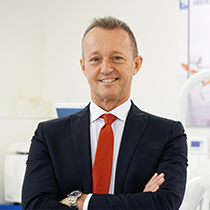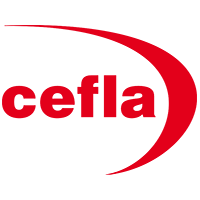
Interview with Paolo Bussolari
Innovation for Cefla > BU Medical Equipment > Highlights
What innovation is the Medical Equipment BU carrying forward most successfully?
“Innovation is a significant change that delivers tangible benefits either to customers or within company processes. “Incorporating innovation into a system” involves making the most of investment and resources. That means examining every aspect linked to the benefits innovation brings. It means focusing on everything from business model to product, from processes to the way data is collected, the organisation itself and, of course, Service.
The re-engineering of product platforms, production systems and organisational models have been – and remain – the innovations that have generated the most success for the Medical Equipment BU. At present, the key strategic projects – and the ones expected to generate the highest industrial and market returns – are undoubtedly the new software platform and the new multi-segment PAN2D/3D Platform.”
How does the market benefit?
“In addition to bringing efficiency and sharpening competitiveness, innovation gives meaning to investment. A product without any improvements in quality, performance or production efficiency has no reason to exist. To be successful and innovative, products or projects must be part of wider integrated strategies and systems.
As medical equipment manufacturers, we work in highly competitive market segments. Innovation is therefore a must: there’s no room for closed-mindedness, fear of the ‘unknown’ or any ‘we’ve always done it like this’ attitude.
This requires steadfast effort, as it’s necessary to cater to true market needs and have a clear understanding of what’s of interest to our customer from a BtBtoC perspective. You need to be fully aware of the logic and dynamics of those who select you, that is, our dealers.
How do you consistently achieve this level of innovation?
By ‘reading the market’ via an Outcome-Driven Innovation approach [Editor’s note: analytical approach based on a job-to-be-done methodology with a product/service strategy that allows more complete extraction of value from current customers on the basis of measurement of their results].
Our distributor takes it for granted that our product is reliable and high-quality, and for the dealer this is crucial. In this context, innovation must also merge seamlessly with corporate stability and credibility.
Another advantage is the level of service: over the years we’ve nurtured this aspect carefully by quantifying, for example, how much lead time is acceptable to a distributor, and focusing on precision and punctuality by investing in the organisation and expansion of supply chains.”
What’s your approach to the market?
“We reach the end market via our dealer network. By cultivating close relations with dealers we can read evident needs yet also detect any gaps. For example, as new technologies are introduced, we provide distribution with close support: boosting technological services becomes a team effort with the dealer. Distributors select you to the extent that, thanks to your products, they can overcome their competitors.
People in the field generate a lot of direct-input market data, which can be much more valuable than market analysis as the latter can be ‘weak’ and less specific.
Innovation and openness to change must touch on all areas of the company, from the sales model – ours being a unique multi-brand set-up – to the integration of new technologies that establish more direct relations with end users.
At the core of these processes lies the product: our constant focus is not just what’s easy for us to create, but what makes us grow and what the market demands. Only through growth and profitability is it possible to reinvest, create new products and keep the company healthy by creating value for the future.
In our Dental Unit core business, the VRP (Variability Reduction Program) project has helped us modernise our production model, allowing us to double the number of products compared to just 5 years ago. It’s also allowed us to constructively question our own systems: from design to the supply chain, from production lines to flexibility and output capacity.
Expansion into new segments is a key part of our strategy (as highlighted by the 2010 takeover of Newtom). We’re now entering new markets: for example, we’re emerging from the diagnostic sector to embrace the pro-aesthetic sector (i.e. digital workflows in which the digital cycle concerning implantology and orthodontics is completed with new technological aids such as scanners, opening up unprecedented scenarios).
These innovations are transforming us from equipment manufacturers into providers of complete solutions for dental practices, something only a large group can offer: this entails not just good growth prospects for our company but a further strengthening of our position in the diagnostics segment.
The latest acquisitions in terms of technological know-how – BioSAFin, Exalens, Advansid and Elettromeccanica F.E.R. – broaden the skills that drive technological progress, enabling new development techniques and seamlessly incorporating these innovations into the system. More specifically, the latest additions to the group include:
BioSAFin: whose production ranges from implants to aligners, from software to the ‘Crea’ digital centre
Exalens: involved in software development, AI and scanner integration.
AdvanSiD: applies unmatched expertise to the development of CMOS silicon sensors.
Electromechanics F.E.R.: manufactures electromechanical power generation components for our X-ray products.
Amalgamating these takeover-related skills into the overall system also presupposes changes to behavioural models that involve integration of different experiences to ensure the ‘ecosystem’ progresses as a whole.”
Does Cefla have an innovation management model? Can people be considered a key factor?
“Companies have different innovation models. However, they’re all based on people’s behavioural models. People increasingly need to be responsible leaders yet should also be first-movers and continuously question their own work. In a sense, they should ‘compete with themselves’ yet always bear in mind what their team is capable of achieving. This requires a major shift in mindset.
It’s essential that each company area look outward. For example, R&D must be permeated by curiosity in new technology. Furthermore, each area should be capable of continuous self-improvement to re-engineer its processes and organisational models.
People, investment, products and processes forge innovation. Yet this demands an open mind and a strong sense of duty towards the ultimate outcome of your work. Being responsible means observing company provisions and procedures, pursuing assigned goals and matching solutions to problems.
As a business, we must be able to identify, support and bring out the best in the ‘heroes of change’ who are everywhere: from algorithm experts to those opening up new markets and new suppliers. Managing people to the best of their ability also means defining and mapping priorities to direct efforts constructively, establishing behavioural rules. There’s also the challenge of – regardless of age – combining traditional skills with more cutting-edge ones. And knowing when it’s time to leave your comfort zone can be critical.
“Innovation distinguishes a leader from a follower”, said Steve Jobs. To implement it you must have the humility and ability to understand new technologies. You need an approach that is dynamic and fast, yet simultaneously in-depth, avoiding the superficiality that often permeates our ever-faster world.
Driving such innovation forward also means learning from one’s failures, seeing them as opportunities to make smart changes. Success comes when ideas and experience merge to form solutions and create value for the Company. This presupposes a cultural change: cooperation between people is a crucial ingredient in the design of innovation.
Creating value over time is our mission, one that clearly expresses our commitment to growth, powered by heavy, targeted investment in segments we see as essential.”
Have we set market trends with our innovation?
“In the Treatment sector we’re undeniably innovators and market leaders.
In the Imaging segment we’re one of today’s leading players thanks to the key takeovers of the past 5 years. The product is the key to achieving and maintaining a market-leading position. The years 2024 and 2025 will be crucial for investment and the launch of new products.
The new Software platform will be a major challenge, as the Medical Equipment BU has been using the NewTom NNT platform since 2010 and has never before developed Diagnostic Software from scratch. Nevertheless, technological and market changes require we create a new system. In addition to higher performance, it must deliver benefits in terms of future implementation, maintenance and integration with third-party systems.
In the Sterilization sector, our autoclaves have incorporated major innovations that make the range ever-more comprehensive. In 2025 we expect major developments in this segment too.”
Is sustainability innovation?
“Innovation is an integral part of every future-focused project or investment. Value creation means bettering ourselves every day to become more competitive, more dependable and ready for future challenges, qualities essential to attaining sustainability.”


